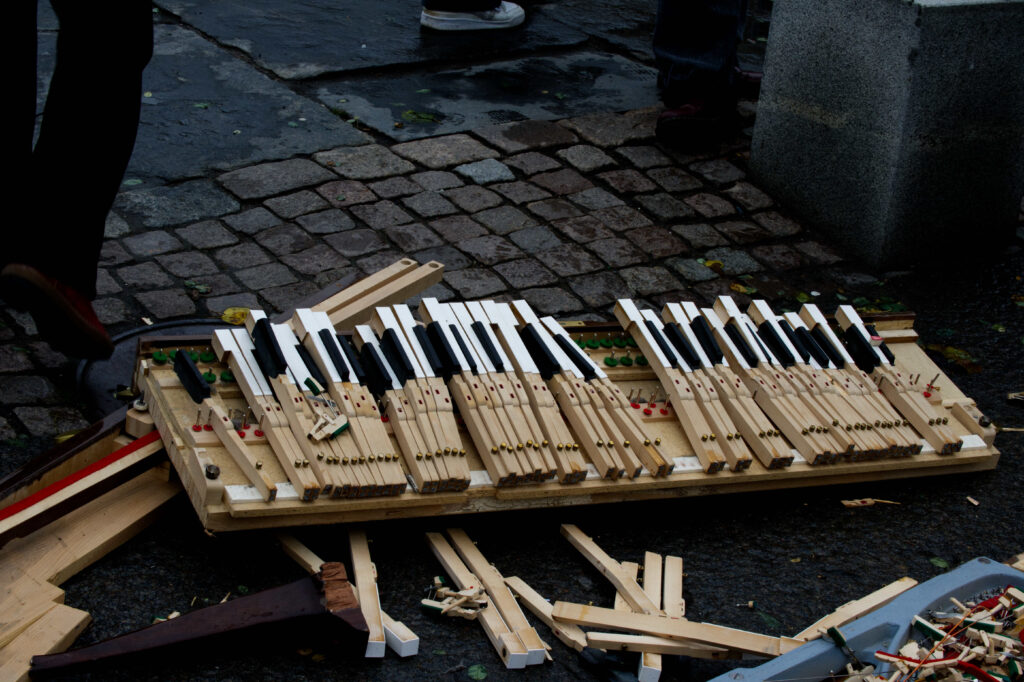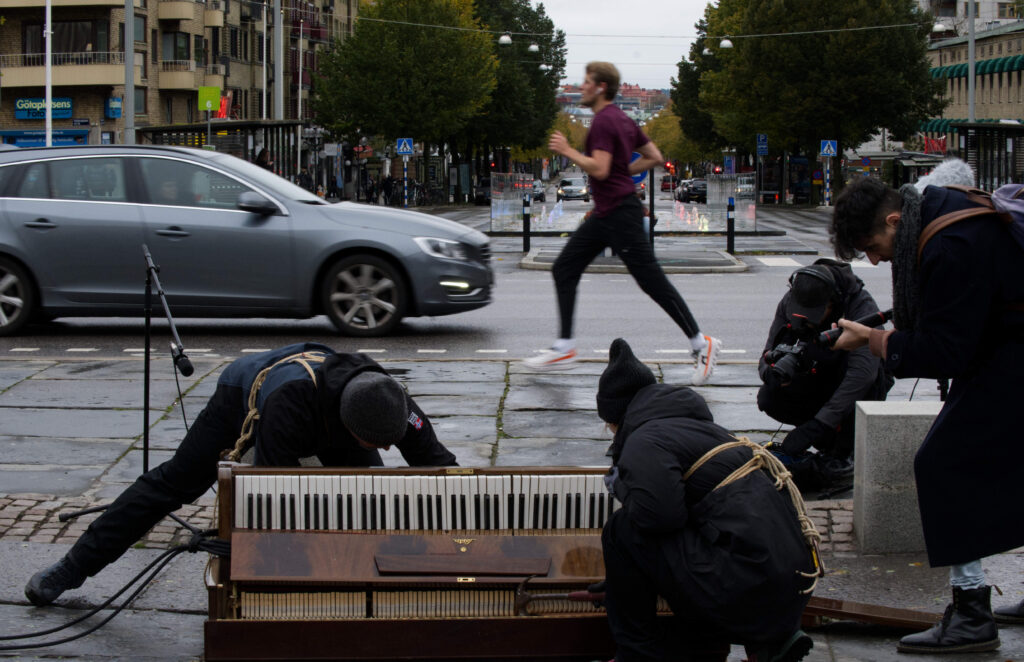‘The sad and spiritual journey of a piano
Götaplatsen 22/10-2023
Exchange residency Gothenburg, Sweden & Vilnius, Lithuania
Creators/Performers: Toby Kassell & Inga Kuznecova

Video: Emiliano Sacripanti/ Guest Platform
The Sad and Spiritual Journey of a Piano. An artistic action performed at Götaplatsen, Göteborg and a studio presentation in Art Printing House Vilnius, October 30th, 2023.
Götaplatsen is Gothenburg’s cultural hub, enclosed by the Gothenburg Concert Hall (where the Gothenburg Symphony Orchestra resides), the Gothenburg Museum of Art, the Gothenburg City Theatre and the City Library.
At the centre of the square presides the Poseidon statue by Carl Milles—the statue
has become one of the symbols of the city. On the city’s annual culture festival different Swedish musical artists usually perform for free at the square as well as dance performances from GöteborgsOperans Danskompani.
This summer, in connection with Göteborgs Konsthall’s 100 year anniversary exhibition “I imagine a Home”, the City of Gothenburg funded an artwork that allowed a structure to occupy the square. It was called Drömmarnas Monument [The Monument of Dreams], and acted as a Gesamtkunstwerk, a social sculpture, and a three-month manifestation for freedom in the arts in Gothenburg. The work served as a stage for the
artist-driven and communal forces that characterize the soul of the city. This was a temporary collective structure during the anniversary exhibition “I imagine a home”. It acted as a forum for creativity and discussions about current arts policy, gentrification, and the conditions for art in the city. The Monument of Dreams, served as an artistic intervention in the middle of Götaplatsen.
As a background to the monument, there is an ongoing debate about the construction of the city’s cultural sites among rent increases, new high-rise buildings, fallen artistic activities and a cut cultural budget. In what way is resistance to the orderly and the rational important in a democracy? What do we dream of? What freedom are we talking about? The structure hosted many performances and artistic
actions during its occupation from artists across all genres and fields. Because of the attention this work attracted it has now opened the flood gates for Götaplatsen to be a public space where artistic actions
can happen.
As part of an artistic residency funded by the Västra Götaland region (Dance+), 2 artists from the dance field in Sweden (Toby Kassell) and Lithuania (Inga Kuznecova) were selected to spend 1 week in each respected country to connect, share artistic visions, process strategies and lay the groundwork for further possible collaborations in the future. Kassell and Kuznecova quickly decided to attempt a physical action in a public space by dragging a piano, being physically attached with rope harnesses, across Götaplatsen and then slowly destroy it with different sized hammers. This was documented with sound and video recording, photographs and witnessed by the public. It became apparent that this type of action can be contextualized by referring to the Fluxus movement of the last century and perhaps also seen as an act of artistic protest by referring to Drömmarnas Monument.
It is important to note that the decision to publicly destroy the piano should not be viewed as a violent or nihilistic act but rather the act of exposing the core of an idea, zooming in and attempting to find something new, perhaps even something more honest within the work and within ourselves. The piano that was included in the performance was no longer fully functional and beyond reasonable repair, its
presence becoming an aesthetic symbol of something rather than a practical tool for creating music. The performance can also be seen as a homage to the instrument and a final performance before
retirement.
Small pieces of the piano (mostly keys, hammers and fragments of the internal frame) were collected and transported to Vilnius to be incorporated in the second part of the residency where Kassell and Kuznecova created a studio performance and researched material drawing from the physical embodied
memories from the artistic action in Göteborg.
This material emerged through 5 days of improvisation with the physical objects collected from the performance at Götaplatsen. Hemp ropes were replaced by hemp string which were tied in a similar fashion to the body as in Sweden and connected to the keys, hammers and small metal frame fragments of the piano. The large public square was replaced by an enclosed studio space. This may possibly be considered as a zooming in or minimization/fragmentation of the original work. The performers bodies
were also connected in a similar way thereby connecting all physical material holistically. The performers generated movement guided by the consequential sounds of the piano pieces and the tension of the string between their bodies, maintaining the theme of dragging the piano in the original
score. This resulted in the dancers slowly becoming more and more entangled with the material drawing their bodies closer and closer over the duration of the performance, progressively restricting the movement possibilities until finally only the bare minimum was possible. 8 mins of edited film and sound material was played on a loop as a backdrop for the duration of the performance as a direct attempt to connect the work across international borders.
The work was shown in Art Printing House
Vilnius October 30, 2023.
Text: Toby Kassell

